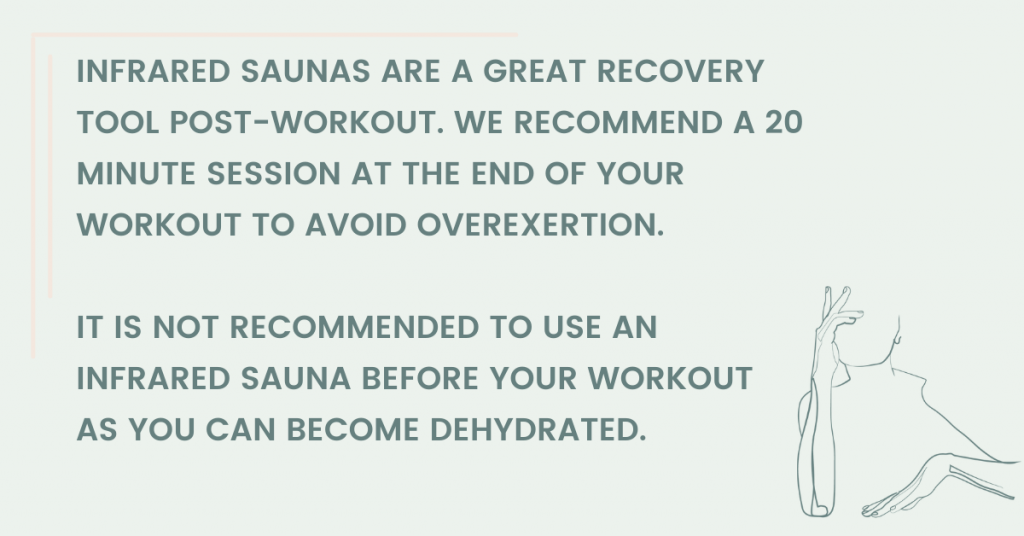Infrared therapy is a powerful healing technique that can help alleviate pain, reduce inflammation, and improve blood circulation. But how long should you do infrared therapy for the best results? In this article, we will explore the benefits of infrared therapy, how long you should do it for, and some tips for making the most out of your infrared therapy sessions. So, if you’re looking for a natural, non-invasive way to improve your overall wellness, read on to learn more about infrared therapy and how long you should do it for.
The recommended infrared sauna session length is 10-15 minutes, 2-3 times per week. It is advisable to start with a lower dose and increase the session length gradually over time as your body adjusts to the heat. It is also important to stay hydrated and to end the session when you start to feel uncomfortable. It is not recommended to stay in an infrared sauna for more than 30 minutes.

Contents
What is Infrared Therapy?
Infrared therapy is a form of light therapy which uses infrared radiation to stimulate the body’s cells. This type of therapy is used to treat conditions such as pain, inflammation, and muscle tension. It is also used to improve circulation, reduce stress, and promote healing. Infrared therapy is becoming increasingly popular due to its ability to penetrate deeply into the body and provide a wide range of health benefits.
The science behind infrared therapy is based on the fact that the radiation emitted by the infrared lamps is able to penetrate deep into the body’s tissues and muscles. This is due to the wavelength of the radiation, which is longer than visible light. As the radiation penetrates the body, it is absorbed by the cells, which then respond by releasing beneficial chemicals. These chemicals help to reduce inflammation and pain, as well as promote healing.
Infrared therapy is a safe and non-invasive treatment which is accessible to most people. It is often used in conjunction with other forms of treatment, such as massage and physical therapy, to get the most out of the therapy.
How Long Should You Do Infrared Therapy?
The length of time required for infrared therapy can vary depending on the type of condition being treated and the individual’s response to the therapy. Generally, it is recommended to start with shorter sessions of 10 to 20 minutes and gradually increase the length of time spent in the infrared lamp.
In most cases, it is best to start with small doses of infrared radiation and gradually increase as the body adjusts to the therapy. This will help to reduce the risk of any adverse reactions to the treatment and ensure that the most effective results are achieved.
For those using infrared therapy to treat chronic conditions, such as arthritis or fibromyalgia, it is recommended to use the therapy for a longer period of time. Generally, the treatments should be carried out for 30 minutes to an hour each day for a period of two to three weeks. This will ensure that the body has enough time to adjust to the therapy and the results will be more noticeable.
What Are the Benefits of Infrared Therapy?
Infrared therapy is one of the most effective forms of light therapy and has a wide range of benefits. These include:
Reducing Pain and Inflammation
Infrared therapy is particularly effective at reducing pain and inflammation in the body. The radiation emitted by the infrared lamps penetrates deeply into the body, stimulating the cells and reducing inflammation. This can help to reduce pain and improve the healing process.
Improving Circulation
Infrared therapy is also beneficial for improving circulation. The radiation stimulates the cells and increases the flow of oxygenated blood throughout the body. This helps to reduce muscle tension, improve flexibility, and reduce fatigue.
Promoting Healing
Infrared radiation is able to stimulate the body’s natural healing process. This can help to speed up the recovery time from injuries and illnesses, as well as reduce the risk of infection.
Are There Any Risks to Infrared Therapy?
Although infrared therapy is generally safe and non-invasive, there are some potential risks associated with the treatment. These include:
Skin Irritation
The radiation emitted by the infrared lamps can cause skin irritation in some people. It is important to be aware of any skin sensitivity before beginning infrared therapy and to avoid direct contact with the lamps.
Eye Damage
The radiation emitted by the infrared lamps can also cause eye damage if not used properly. It is important to make sure that the lamps are not pointed directly at the eyes and that protective eyewear is worn during the treatment.
Overall, infrared therapy is a safe and effective form of light therapy which can provide a wide range of health benefits. It is important to ensure that the treatment is carried out properly and for the correct length of time in order to get the most out of the therapy.
Top 6 Frequently Asked Questions
Q1. What is infrared?
Answer: Infrared is a type of energy, which is invisible to the human eye, and is measured in wavelengths. It has the ability to penetrate and heat objects that are in its path. Infrared energy is used in many applications, such as in medical treatments, cooking, and heating. Additionally, it is used in infrared saunas, which are a type of sauna that uses infrared radiation to heat the body rather than traditional steam or hot air.
Q2. How does infrared heat the body?
Answer: Infrared radiation works by heating the body from the inside out. It penetrates the skin and is absorbed by the body’s cells, which then convert the energy into heat. This heat then spreads throughout the body, providing a deep, soothing warmth that can help to relax sore muscles and ease joint pain.
Q3. How long should one do infrared?
Answer: The amount of time that someone should spend in an infrared sauna will vary depending on their individual needs and preferences. Generally, it is recommended that a person spend 15 to 30 minutes in an infrared sauna session, but this can be adjusted according to the individual’s comfort level and desired level of heat. Additionally, it is important to make sure that the temperature in the sauna is not too hot, as this can be uncomfortable and potentially dangerous.
Q4. Are there any benefits to doing infrared?
Answer: Yes, there are many potential benefits to doing infrared sauna sessions. These include improved circulation, detoxification, relaxation, stress relief, pain relief, and improved skin health. Additionally, infrared saunas may also help to boost the immune system, reduce inflammation, and improve overall well-being.
Q5. Are there any risks associated with doing infrared?
Answer: Yes, there are potential risks associated with doing infrared sauna sessions. These include dehydration, overheating, skin irritation, and fainting. It is important to ensure that the temperature of the sauna is not too hot, that plenty of water is consumed during the session, and that the session is not too long. It is also important to talk to a doctor before beginning an infrared sauna regimen, as it may not be suitable for everyone.
Q6. What should one wear while doing infrared?
Answer: When doing an infrared sauna, it is important to wear loose-fitting clothing that is made of breathable materials. Additionally, it is important to avoid wearing any metal jewelry or objects, as these can become hot and cause burns. It is also important to wear eye protection, such as sunglasses or goggles, as the infrared radiation can be damaging to the eyes.
Infrared sauna to improve your health and recovery
In conclusion, infrared therapy can be a beneficial tool for reducing pain and inflammation and promoting healing. However, it is important to consult your doctor or physiotherapist before engaging in infrared therapy, as the ideal duration and frequency of sessions will depend on your individual needs and goals. With the help of a healthcare professional, infrared therapy can be a safe and effective way to improve your wellbeing.








